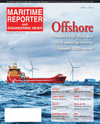
Page 65: of Maritime Reporter Magazine (April 2012)
Offshore Deepwater Annual
Read this page in Pdf, Flash or Html5 edition of April 2012 Maritime Reporter Magazine
April 2012www.marinelink.com 61to its extremely low internal resistance. The batteries cath- ode is nickel manganese cobalt and has about 20-25% more power than competing lithium ion versions. DNV is heading this research project, which is dubbedFellowSHIP, and it includes high profile partners includ- ing Eidesvik Offshore, the owner of the ship and Wärtsilä, who provides power solutions for the marine market. In this, the next project phase, an energy storage capability is to be introduced to the energy system. This allows the ben- efits of a true hybrid energy system to be explored. The primary potential benefits of the hybrid energy sys- tem for a ship like the Viking Lady are a 20/30% reduction in fuel consumption and CO2 emissions through smootherand more efficient operation of the engines and fuel cell. The reductions of other exhaust components are even higher. The project is interesting in a number of respects as ves- sel owners large and small, globally, are facing mandates to reduce emissions. At the same time, marine operators are facing record high fuel costs, a trend which shows no signs of abatement in the long-term. Based on these actualcosts, the return on investment period for the hybrid system is estimated to be less than two years. We know that the hybrid system will reduce the energy consumption,? said Bjørn-Johan Vartdal, DNVs project manager. When operating, for example, on dynamic po- sitioning, there will be a major fuel saving potential. When in harbor, too, the ship should be able to operate on the fuel cell and its battery power alone, which will reduce emis- sions significantly. For environmentally sensitive areas, this will be an essential benefit. Additional benefits are related to reductions in machinery maintenance costs and in noiseand vibrations.? A comprehensive measurement program will be carried out to verify the savings potential. The hy- brid system will also be modeled in detail. Calibrated andverified process models will facilitate simulation and opti- mization of future hybrid systems. The new DNV class rules for battery-powered ships have been developed in parallel to this. These are the first class rules developed in order for batteries to be used as part of a vessels propul- sion energy - both as hybrid solutions and for pure? bat- tery-driven vessels. The project is due for completion in 2013.For more information, visit: www.eidesvik.no www.dnv.com www.wartsila.com www.corvus-energy.com

 64
64

 66
66
